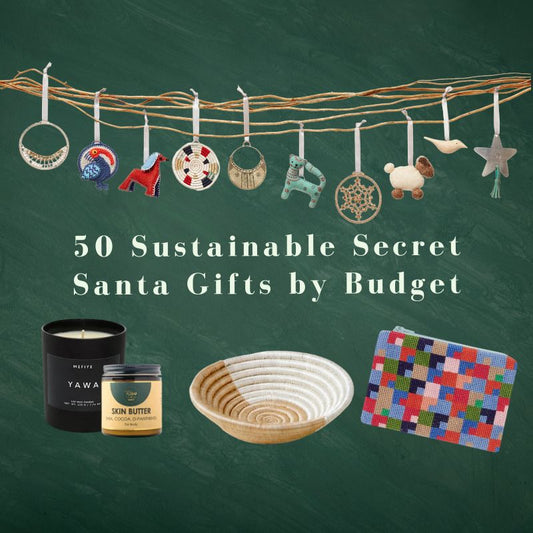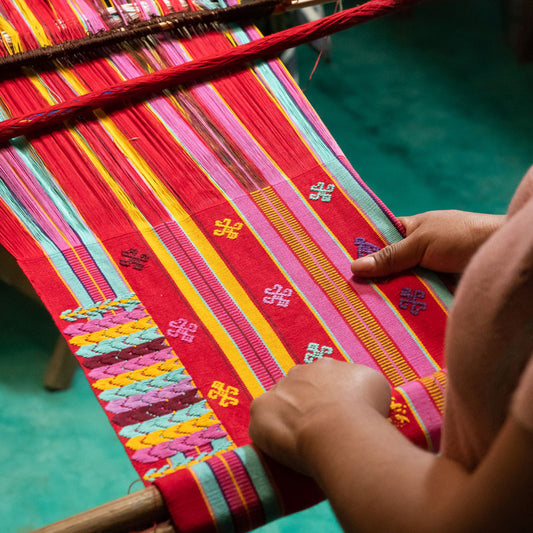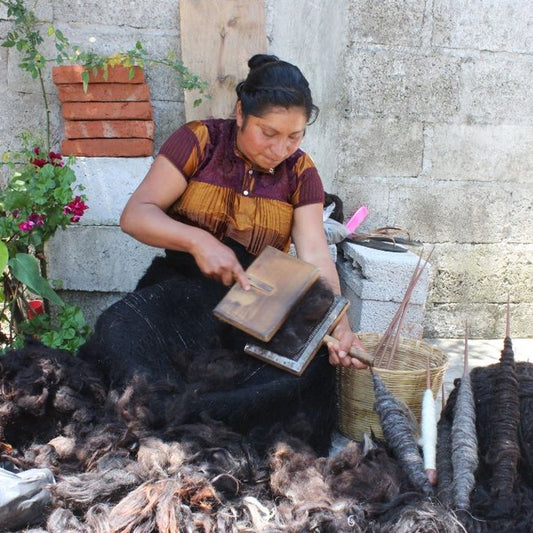
Kemi Lawson is a woman in demand. A champion of African and African-inspired design, Kemi is the co-founder of homeware and lifestyle online boutique, The Cornrow, and founder of Cottage Noir, a home renovation page on Instagram that follows the refurbishment of her Stanmore home. Drawing on her ancestry, this beautiful cottage is steeped in meaningful design, bright and bold prints, and above all, is a sanctuary for her two daughters, who can freely embrace their heritage. Businesses aside, Kemi is also a panellist, has appeared in Stylist, Reclaim, and Harper’s Bazaar, and is leading the charge to introduce black history into the curriculum of her daughter's school.
In the first instalment of our monthly interviews with AKOJO MARKET community members, we caught up with the formidable entrepreneur about BAIM representation in the world of interiors, celebrating “under-explored” creatives, and curating a home that is significant to you and your family.
Having recently departed from the corporate world, what does a normal day look like for you? What is this balancing act comprised of?
One of the reasons I left the corporate world is I didn’t like all the stress, deadlines and the anxiety associated with the finance industry and I moved to The Cornrow because that was my passion and created a lifestyle I could control more. I realise this is a great privilege which I don’t take it for granted and feel like I now, I have to make the most of it.
I try set myself attainable goals so I don’t feel too much pressure. Another reason I set up The Cornrow is because I wanted to spend quality time with my girls and be more flexible, so I make sure I always adhere to that goal. A normal day consists of calls with brands and consultants, facetimes with my sister/co-founder who is based in Canada, spending time with my daughters and keeping up to date with the logistics, social media and finance side of The Cornrow – all in a different order and balance each day!).
The best days are when I manage to squeeze in a trip to an art gallery or museum for inspiration as well , I am looking forward to seeing Theaster Gates at the Whitechapel Gallery this week. And the very best days is when I can add in some self-care to the mix too!)
What’s going on in your world in terms of your projects and work at the moment?
I think the main thing is The Cornrow, which I run with my sister, and we’re going to celebrate our first anniversary soon on November 8th. It’s just been a whirlwind of a year – both as a passion project and managing the logistics of running the business. And it’s definitely a juggle between those two and making sure you tend to both sides of the business.
The priority for us right now is black history month. We’re trying to produce content on our platforms and with our customers about how we’re celebrating black history month, both on a personal level with Cottage Noir and also promoting creatives on The Cornrow site as well. Already I failed in the attainable goals point I mentioned earlier , as I promised we would do a post a day and we have not managed this!! It’s a real learning point for me here. Because we want every post to be super special, we really have to learn to be realistic given the time it takes to create them.
The other priority we have is Christmas coming up, and as you know it’s a big month for retailers and for us – we had a great Christmas last year which we weren’t expecting because we had just launched. We were surprised to find out how much our customers loved our black angels in particular. You would think black angels would be everywhere but it’s actually a really rare sight in the shops. And it’s really important to us that when we have children and when they draw angels, they draw people that really look like them, you know. And it’s also important for our non-black customers who want to have diverse Christmas decorations.
We are also very excited to have not one but three pop ups coming up in the run up to Christmas, watch this space! I think is will definitely need some more of that self care I mentioned in the New Year!

You’ve had amazing exposure recently – you’ve featured in Harper’s Bazaar, Metro and Reclaim Magazine – what do you attribute the great interest in your work to at the moment?
When I decorated my home, it was very much a private thing. It was just me (my mum’s partner Jonathon was also very helpful) but mainly I wanted to design something fun and inspiring for my daughters. Honestly, if it was just me living at home, I’d probably have off-white walls and one big artwork in each room!
It was very personal. I bought all the interior magazines, but I never expected to be on one of them. Partly because I didn’t see anything in the magazines that reflected my home or my aesthetic. But I thought I can’t be the only one so that prompted me to start sharing on Cottage Noir on Instagram which attracted interest from the media. I think things took off especially due to the killing of George Floyd and Black Lives Matter movement, the interior world really realised how underrepresented black voices had been. I definitely wouldn’t have had that exposure a couple of years ago.
Secondly, regarding my house, I just think it was so different. Even for a black home because I really took the memo and ran with it. For instance, some people have a few black and white pictures of their grandparents but I have a wall. It was just a lifetime of collecting and thinking about things that all exploded into this house.
Are you pleased with the coverage? Are you happy with how it’s being represented and how you are being represented?
Because I’m kind of new to it all, I wasn’t sure what to expect. But I’m happy because I’ve managed to control the narrative and the journalists have been willing to learn and are interested and engaged. And so yeah, I’m sure it’s not all going to be smooth sailing but so far, it’s been great. And the trade-off is obviously It’s a weird thing to show your home in a magazine, but I just think it’s important to show a different way of living and a different aesthetic.
"The onus is really on the interior design industry to find talent, to nurture talent. There’s been a lot of talking, but we need action."
A well-known magazine recently put out a list of top interior designers and it was a real shock to see such a lack of diversity. What can change and what is already on the horizon for change within the industry?
The media has now realised that lists like that are unacceptable. That’s a big step because a few years ago no one would have batted an eyelid.
Homes and Gardens recently published a list that included black and Asian faces, so I think people now know that it’s not acceptable which is great. I’m not an interior designer, but I felt for them because it’s incredibly demotivating not to be represented. And for new people coming up in the industry looking to people to aspire to or for people who look like them, there’s nothing there and that’s really harmful.
The onus is on the interior design industry to find talent and to nurture talent. There’s been a lot of talking, but we need action. Talented people within the industry need support to advance their careers.
What we love about your account is how informative and fun it is. How did you come up with the thematic content you put out for black history month and what in your eyes should it be about?
What we’re trying to do with The Cornrow’s social content, is, a lot of the time, show something a bit different. It’s a bit like the conversations I have with my daughter’s school. They’re doing quite well in terms of black history month and post George Floyd, and I said to them, it’s not just about Rosa Parks and Martin Luther King, you know. There are other stories you can tell that are relevant too, if not more relevant to British school children.
What we’re always trying to do is showcase the under-explored – creatives you might not have heard of. We recently featured a furniture designer who’s been working for 40 years on these amazing pieces. We all know David Linley and all these men who have all these privileges and attention, but not him.
We always try to do things in an entertaining way. Secondly, you hit the nail on the head when you said the “fun” part. I always think it’s so important to do it in an entertaining way. I’m not a lecturer, I’m not an academic. There are other websites that do that wonderfully, so for me, it’s trying to put ideas in an informative way and hopefully you can explore more. Like we did something on the cocoa trade. We did graphics and put some thought-provoking posts up and then, if you’re interested, then you can explore more. It’s an entertaining taster into issues that we are genuinely passionate about.

Going back to interiors and your home, what are your influences? What inspires you daily when thinking about curating products for The Cornrow or decorations for your house?
I draw inspiration from my African and Caribbean heritage and the themes and aesthetics I absorbed through living there, through visiting there, and through researching a lot. For example, I love stripes and geometry. I think there’s an inter-generational, cultural appreciation that gets passed down, and as a result I’m always attracted to these timeless and historical African aesthetics.
I like colour. But I always say, don’t just think of African designers as bright primary colours, but natural colours as well. Earth tones and grass tones are also important.
And then I think, my daughters. I am very conscious I am bringing two little black girls into a world where they are a minority. They were the only black girls in their class for instance. They’re living in a country where it’s not that easy to be a black woman a lot of the time. I really want the home to be a fun solace for them. We have secret doors, their rooms have these over-the-top canopies. I want it to be a light-hearted fun place where it is also filled with representations of them and their family, which hopefully they can see and will subliminally help to build them up their confidence and their knowledge of themselves and their heritage.
How do you go about trying to embed all of these concepts when it comes to sourcing for The Cornrow?
That’s a big thing. In a lot of ways, Cottage Noir is like the testing ground for The Cornrow. A lot of products, if not everything, have been used, or eaten, played with or worn or is on the wall. It’s always things items that I would enjoy or my family would enjoy.
Secondly, with Cornrow, we’re really trying to make it affordable. There’s lots of wonderful kinds of artwork or fabric that are very expensive and beautiful but we’re trying to make our products affordable so that we can make the maximum impact on the UK retail space, and beyond!
Do you have any advice for others in decorating a home that is a little different or more meaningful?
Just go for it. Follow your instincts.
I firmly believe that every home should be different because everybody is different. I love a classic hotel lobby as much as anyone else, but that’s a hotel lobby – your home shouldn’t look like that. It should be a reflection of you, your passions, your interests, and it should be a celebration of you and your family.
It’s actually an easier way to decorate if you appreciate what you have. I have old letters my sister wrote to me from boarding school. I framed them up because they’re so cute. Or my daughter’s first bridesmaid shoes are by her fireplace. It’s about appreciating your personal history. Treating it like an archive of design objects rather than storing or throwing possessions away. Think of it like little pieces of art or little pieces of family history. And it just develops from there. It’s never going to be complete, or you might not have everything when you move in, but it’s developing a collection of precious items over time.
How do you marry this sentimental approach with interior trends?
I’m very much “I like what I like.” I might like two things that are quite different and I’m like “they’ll work together!” and through sheer will power they do!
I don’t go for “trends” so much. Trends are there to make you consume more for the corporates, not because you need them.
Prioritise what you want to feel when you go in this room. Is it a calming room? An energising room? And make that your starting point. And then every few years have another look at it and refresh.
And finally if you want some trends for me, it’s items that last, items that are sustainable and items that tell a story. That is what we see is getting more popular, and I hope this is a trend that is here to stay!!
For more tips on interior and other inspiring content, follow Kemi on Cottage Noir and The Cornrow.



